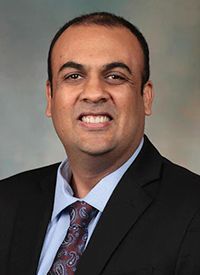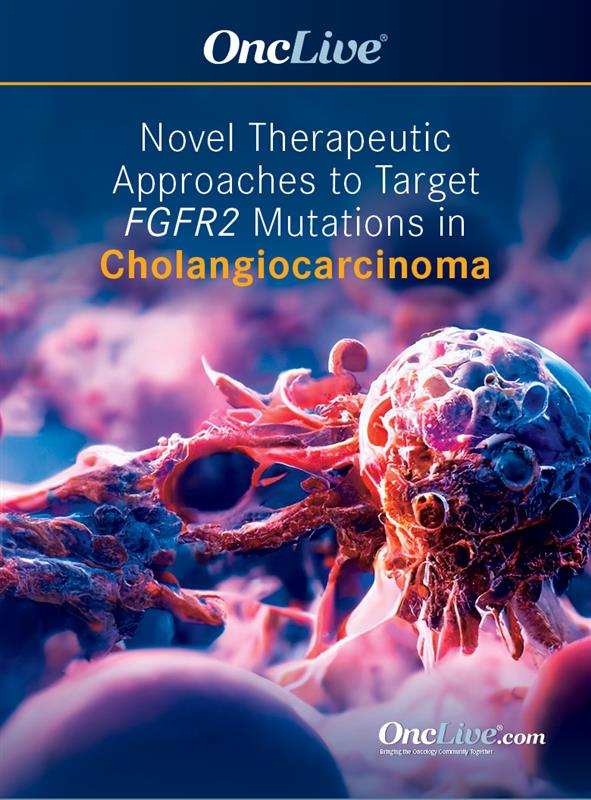Publication
Article
Phase 1 Data Support Further Investigation of RLY-4008 in FGFR2+ Cholangiocarcinoma
Author(s):
The FGFR2 inhibitor RLY-4008 generated early evidence of efficacy in patients with cholangiocarcinoma harboring FGFR2 fusions, according to findings from the phase 1/2 ReFocus trial, which were presented at the 2023 ASCO Annual Meeting.
Mitesh J. Borad, MD

The FGFR2 inhibitor RLY-4008 generated early evidence of efficacy in patients with cholangiocarcinoma harboring FGFR2 fusions, according to findings from the phase 1/2 ReFocus trial (NCT04526106), which were presented at the 2023 ASCO Annual Meeting.1
Results from the study showed that the patients with FGFR inhibitor–naïve, FGFR2 fusion–positive cholangiocarcinoma who received at least 70 mg of RLY-4008 across all dosing schedules (n = 11) achieved an overall response rate (ORR) of 73%, including 8 with a partial response (PR) and 3 with stable disease (SD). All 4 patients who received the agent at 70 mg daily responded, and 1 patient went on to receive resection with curative intent. The patients with FGFR inhibitor–naïve, FGFR2 fusion–positive cholangiocarcinoma who received less than 70 mg of RLY-4008 across all dosing schedules (n = 14) had an ORR of 36%, including 5 with a PR, 6 with SD, and 3 with progressive disease (PD). The tumor reduction rate in this population was 92%.
In the population of patients with FGFR inhibitor–refractory, FGFR2 fusion–positive cholangiocarcinoma who received at least 70 mg of RLY-4008 across all dosing schedules (n = 14), the ORR was 21%, with 3, 10, and 1 patient achieving PR, SD, and PD, respectively. The patients with FGFR inhibitor–refractory, FGFR2 fusion–positive cholangiocarcinoma who received less than 70 mg of RLY-4008 across all dosing schedules (n = 36) had an ORR of 11%, including 4, 23, and 7 patients achieving PR, SD, or PD, respectively. The tumor reduction rate in this population was 70%.
“Clearly, this agent has considerable preliminary antitumor activity [and we] see activity even in that very refractory population,” Mitesh J. Borad, MD, of Mayo Clinic Comprehensive Cancer Center in Phoenix, Arizona, stated in a presentation of the data.
The pan-FGFR inhibitors that are currently available for patients with solid tumors include pemigatinib (Pemazyre), which elicited the FGFR1 off-isoform toxicity hyperphosphatemia in 94% of patients and the FGFR4 off-isoform toxicity diarrhea in 47% of patients2; futibatinib (Lytgobi), which elicited hyperphosphatemia and diarrhea in 88% and 39% of patients, respectively3; and erdafitinib (Balversa), which elicited hyperphosphatemia and diarrhea in 76% and 47% of patients, respectively.4 However, selective FGFR2 targeting has yet to be achieved. RLY-4008 is the first highly selective and irreversible FGFR2 inhibitor.
Phase 1 of ReFocus, the dose escalation phase, aimed to determine the recommended phase 2 dose and proof of mechanism of RLY-4008, and evaluated the safety, pharmacokinetics, pharmacodynamics, and efficacy of the agent in patients with FGFR2-altered solid tumors.1 The phase 2 dose expansion part of the trial is ongoing to determine the definitive efficacy of RLY-4008 with registrational intent. This phase is evaluating ORR, duration of response (DOR), safety, and quality of life in patients with FGFR2 fusion–positive cholangiocarcinoma and includes FGFR2-altered tumor agnostic cohorts.
Phase 1 of the trial evaluated RLY-4008 at 3 dosing schedules. At the daily dosing schedule, patients received the agent at a starting dose of 50 mg (n = 12), at which 1 dose-limiting toxicity (DLT) was observed. Patients were then escalated to receive 60 mg (n = 4) or 70 mg (n = 11), which was determined to be the recommended phase 2 dose (RP2D), or de-escalated to receive 40 mg (n = 11), 30 mg (n = 11), or 20 mg (n = 9). At the daily dosing schedule, 51.7% (n = 30), 37.9% (n = 22), and 3.4% (n = 2) of patients required dose interruptions, dose reductions, or treatment discontinuation because of adverse effects (AEs), respectively.
At the twice daily dosing schedule, patients received RLY-4008 at a starting dose of 50 mg (n = 7), at which 2 DLTs were observed, and were then escalated to receive the agent at 100 mg (n = 3), at which 2 DLTs were observed, or de-escalated to receive the agent at 30 mg (n = 3) or 20 mg (n = 4). In total, 82.4% (n = 14), 70.6% (n = 12), and 0% of patients required dose interruptions, dose reductions, or treatment discontinuation because of AEs, respectively.
At the daily dosing schedule for 3 weeks on and 1 week off, patients received RLY-4008 at a starting dose of 50 mg (n = 11) and were then escalated to receive the agent at 60 mg (n = 6), 70 mg (n = 9), 90 mg (n = 9), or 100 mg (n = 6), at which 1 DLT was observed. A total of 58.5% (n = 24), 48.8% (n = 20), and 2.4% (n = 1) of patients required dose interruptions, dose reductions, or treatment discontinuation because of AEs, respectively.
Pharmacokinetic and pharmacodynamic analyses predicted the RP2D to have a median of at least 96% receptor occupancy with an effective half-life of around 18 hours to 26 hours. Normal serum phosphate levels over time indicated clinically insignificant FGFR1 inhibition.
Phase 1 included 116 patients in the safety population, 91 of whom had cholangiocarcinoma. Efficacy was assessed in 75 patients with FGFR2 fusions or rearrangements, 25 of whom were FGFR inhibitor–naïve and 50 of whom were FGFR inhibitor–refractory. Of these patients, 14 had FGFR2 mutations, 10 of whom were FGFR inhibitor–naïve and 4 of whom were FGFR inhibitor–refractory.
In the population of patients with FGFR inhibitor–naïve, FGFR2 fusion–positive cholangiocarcinoma who received at least 70 mg of RLY-4008 across all dosing schedules, the median DOR was 11.2 months, the 6-month progression-free survival (PFS) rate was 100%, and the disease control rate (DCR) was 100%. In the population of patients with FGFR inhibitor–naïve, FGFR2 fusion–positive cholangiocarcinoma who received less than 70 mg of RLY-4008 across all dosing schedules, the median DOR was 5.6 months, the 6-month PFS rate was 70%, and the DCR was 79%. At the data cutoff date, 4 patients who received at least 70 mg of the agent and 1 patient who received the agent at 50 mg daily for 3 weeks on and 1 week off had ongoing responses.
The patients with FGFR inhibitor–refractory, FGFR2 fusion–positive cholangiocarcinoma who received at least 70 mg of RLY-4008 across all dosing schedules had a median DOR of 5.6 months, a 6-month PFS rate of 43%, and a DCR of 93%. The patients with FGFR inhibitor–refractory, FGFR2 fusion–positive cholangiocarcinoma who received less than 70 mg of RLY-4008 across all dosing schedules had a median DOR of 6.0 months, a 6-month PFS rate of 33%, and a DCR of 75%. At data cutoff, 2 patients who received at least 70 mg of the agent and 1 patient who received the agent at 20 mg daily had ongoing responses.
Of the patients with FGFR2-mutated cholangiocarcinoma, the ORR was 29%, with 2, 2, and 3 patients who received at least 70 mg of RLY-4008 achieving PR, SD, and PD, respectively. In the patients who received less than 70 mg of the agent, 2, 3, and 2 patients had PR, SD, and PD, respectively. In this population, the tumor reduction rate was 64%, and the median duration of exposure was 26.4 weeks (range, 2-62).
Across all doses, the most common all-grade AEs were palmar-plantar erythrodysesthesia (PPE; 57%), stomatitis (57%), nail toxicities (53%), dry mouth (38%), alopecia (28%), retinal pigment epithelial detachment (RPED; 24%), and dry eye (22%), and the most common grade 3 AEs were PPE (22%), stomatitis (10%), and nail toxicities (1%). In the patients who received at least 70 mg of RLY-4008, the most common all-grade AEs were stomatitis (76%), PPE (69%), nail toxicities (67%), alopecia (44%), dry mouth (36%), dry eye (33%), and RPED (24%), and the most common grade 3 AEs were PPE (27%) and stomatitis (18%). In the patients who received less than 70 mg of the agent, the most common AEs were PPE (49%), stomatitis (45%), nail toxicities (45%), dry mouth (39%), RPED (24%), alopecia (18%), and dry eye (14%), and the most common grade 3 AEs were PPE (20%), stomatitis (4%), and nail toxicities (1%).
The investigators observed minimal diarrhea and hyperphosphatemia as well as no grade 4 or 5 AEs. In total, 2.6% (n = 3) of patients discontinued treatment because of AEs.
In the ongoing phase 2 portion of ReFocus, in the 17 FGFR inhibitor–naïve patients with FGFR2 fusions or rearrangements who were enrolled so far and treated with the RP2D, the ORR is 88% and the confirmed ORR is 82.4%, with all patients achieving radiographic tumor reduction and 14 patients achieving a PR. At data cutoff, 15 patients have ongoing responses, and 1 patient has received resection with curative intent. Enrollment completion in this phase is expected in the second half of 2023.
Borad shared a case study from the tumor agnostic cohort of the phase 2 trial of a 46-year-old male with FGFR2 Y375C–mutant metastatic salivary gland carcinoma who previously received carboplatin plus paclitaxel and lenvatinib (Lenvima) and received RLY-4008 in phase 2 of ReFocus at the RP2D. At data cutoff, this patient had achieved a PR. The tumor agnostic data are anticipated in the second half of 2023.
“The evaluation from the tumor agnostic perspective is becoming a higher and higher sought-after strategy in terms of drug development,” Borad concluded.
Disclosures: Dr Borad reports receiving research funding from Relay Therapeutics.
References
- Borad MJ, Schram AM, Kim RD, et al. Updated dose escalation results for ReFocus, a first-in-human study of highly selective FGFR2 inhibitor RLY-4008 in cholangiocarcinoma and other solid tumors. J Clin Oncol. 2023;41(suppl 16):4009. doi:10.1200/JCO.2023.41.16_suppl.4009
- Pemigatinib (Pemazyre). Prescribing information. Incyte. Updated August 2022. Accessed June 9, 2023. https://www.pemazyre.com/pdf/prescribing-information.pdf
- Futibatinib (Lytgobi). Prescribing information. Taiho Pharmaceutical Co. Updated September 2022. Accessed June 9, 2023. https://www.accessdata.fda.gov/drugsatfda_docs/label/2022/214801s000lbl.pdf
- Erdafitinib (Balversa). Prescribing information. Janssen Pharmaceutical Companies. Updated April 2019. Accessed June 9, 2023. https://www.accessdata.fda.gov/drugsatfda_docs/label/2019/212018s000lbl.pdf










